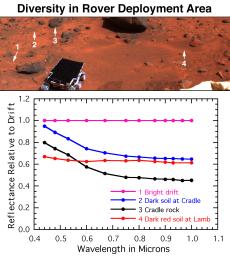
|
Diversity of Soils near Rover Deploy Region
- Click the image above for a larger view
- Full-Res JPEG (1500 x 1672) (264.4 kB)
- Full-Res TIFF (1500 x 1672) (1.7 MB)
Caption:
The surface near the rover's egress from the lander contains bright red drift (#1), dark gray rocks such as Cradle (#3), soil intermediate in color to the rocks and drift (#2), and dark red soil on and around the rock Lamb (#4). Globally, Mars is characterized by similar color variations. The spectra of these sites have been ratioed to the drift to highlight their differences. The rocks are less red and have less of a bend in the spectrum at visible wavelengths, indicating less ferric minerals and a more unweathered composition than drift. The intermediate colored soils appear intermediate in the spectral properties as well. The dark red soil at Lamb is darker than drift by about equally as red; the curvature of spectrum at visible wavelengths indicates either more ferric minerals or a larger particle size.
Background Info:
Mars Pathfinder is the second in NASA's Discovery program of low-cost spacecraft with highly focused science goals. The Jet Propulsion Laboratory, Pasadena, CA, developed and manages the Mars Pathfinder mission for NASA's Office of Space Science, Washington, D.C. JPL is an operating division of the California Institute of Technology (Caltech).
Photojournal note: Sojourner spent 83 days of a planned seven-day mission exploring the Martian terrain, acquiring images, and taking chemical, atmospheric and other measurements. The final data transmission received from Pathfinder was at 10:23 UTC on September 27, 1997. Although mission managers tried to restore full communications during the following five months, the successful mission was terminated on March 10, 1998.
Cataloging Keywords:
| Name | Value | Additional Values |
|---|---|---|
| Target | Mars | |
| System | ||
| Target Type | Planet | |
| Mission | Mars Pathfinder (MPF) | |
| Instrument Host | Mars Pathfinder Lander | |
| Host Type | Lander | |
| Instrument | Imager for Mars Pathfinder (IMP) | |
| Detector | ||
| Extra Keywords | Atmosphere, Color | |
| Acquisition Date | ||
| Release Date | 1997-07-22 | |
| Date in Caption | ||
| Image Credit | NASA/JPL/Johns Hopkins University | |
| Source | photojournal.jpl.nasa.gov/catalog/PIA00754 | |
| Identifier | PIA00754 | |
